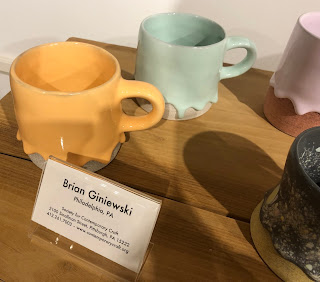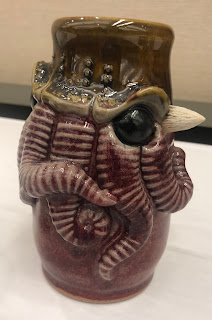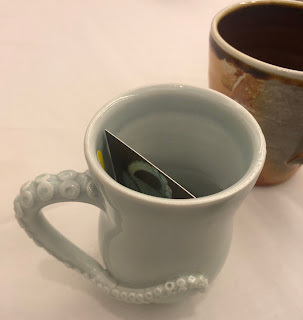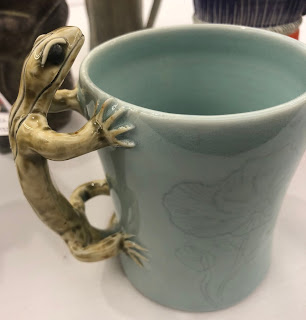 |
| Work by C. J. Niehaus. The small plate in front was one of the first ceramic items I bought in Pittsburgh |
Last month I went to the NCECA (National Council on Education for the Ceramic Arts) Conference in Pittsburgh, PA. I went this year because
I was presenting twice at the conference. My first presentation was a Topical Networking session about students from different backgrounds working in a classroom studio and the challenges and opportunities that represents.
 |
| A main hallway in the convention center had windows overlooking the expo hall. The empty tables in the foreground are the college, university, and community studio tables, but not everyone had arrived on Wednesday. |
My Topical Networking session was fairly well attended and the conversation was insightful and positive. The set up was strange, because the Conference organizers don't really communicate with the presenters. This first presentation was on Wednesday afternoon, before the keynote speaker so a lot of people weren't at the conference yet. The upshot was that they didn't provide microphones, didn't communicate essentially at all with the presenters, and booked two sessions at a time in the same space. It also means the stakes are fairly low. I figured if no one turned up, I could leave early.
 |
| I saw Brett Freund's work in my favorite show in Portland last year but didn't buy one then. I bought one this year. This work is slip cast and 3D printed. |
I arrived on Tuesday because flying from Yakima to Pittsburgh takes all day (2 layovers both ways-- the return trip took 16 hours). Tuesday was the earliest I've ever arrived to an NCECA conference, though this was my tenth conference (I started coming in college). I had to check-in for
my Thursday presentation in on Wednesday morning, then I had most of the day to check out shows and worry about my presentations.
 |
| The main part of the expo hall featured tool, wheel, kiln, and magazine vendors. I had some good discussions with the Bailey folks about my gas kiln and with the Potterbot folks about our 3D printer. |
I devoted a significant amount of my time at the conference to worrying in general. This year's NCECA took place during YVC's finals week, so I had some online submissions and their accompanying questions happening while I was at the conference. Since I was presenting twice, I was able to worry about both presentations and the classes. I was also generally less excited about the other presentations at the conference, though that could have had to do more with my mood than the quality of what was offered.
Whether it was because of the stress of presenting, or finals, or the fact that I attended the conference last year, I found the expo hall and the galleries in the expo hall to be fairly boring and uninspiring. This sounds fairly hard, but on Wednesday, after checking-in for the next day's presentation and then doing some grading in the upstairs hallway, I walked through the expo hall telling myself "ugh, I don't care, I don't want to be here."
 |
| Gallery Spaces and Emerging Artists Spaces in the Expo Hall |
The expo hall is the large room where all the tool vendors, magazine publishers, kiln and wheel companies, etc, show and sell their stuff. Usually I go through this space looking for posters for the YVC clay studio, buying (or just drooling over) tools I want for my studio or the school studio, and talking to people in the school or community studio booths. Last year I spend some time at the 3D printer booth and ended up
asking YVC to buy us a printer (t
hey did).
 |
| My friend Nina in the Chinese classroom at the Cathedral of Learning on the University of Pittsburgh campus |
The best thing about NCECA this year, hands-down, was that my friend Nina came with me. Nina isn't a potter or a ceramicist (her mom is), but she happened to have the week off, so she joined me in Pittsburgh where she proceeded to put up with my high anxiety level for two days and then we had lots of fun going to museums and seeing shows and hanging out with some of her wonderful friends in Pittsburgh.
 |
| Walking around NCECA and Pittsburgh means a lot of steps |
On Wednesday, after my morning check-in and before my afternoon presentation, I met up with Nina and we walked up to see some interesting spots she'd found, have some lunch, and experience the brisk and alternately sunny and snowy March weather. Nina had already been in Pittsburgh several hours before I arrived on Tuesday, so she had scoped out some of the interesting spots to walk near our hotel and the convention center. Incidentally, the spot she wanted to walk on Wednesday was also the spot hosting the main NCECA Invitational show. The show was really good, but I'll save my discussion of that show for a later post.
 |
| I knew exactly what to expect for my Topical Networking session |
My topical networking session was scheduled to happen in same room at the same time as another topical networking session, this one on Maker Spaces. I arrived 30-45 minutes early (anxiety) and found just two people in the room, the women who would be running the other session. They were expecting to meet someone from NCECA before the presentations, but I've been to enough of these conferences to guess we were on our own. The other women were also expecting to be the only ones in the room. I'd figured we'd be sharing a room, but was still a little disappointed that NCECA never actually communicated to the presenters that we were sharing a room, nor did they provide signage or even paper and markers for us to communicate where folks should go (without announcing it over and over again, that is).
 |
| Sculpture "On Top?" by Travis Winters in the Ceramic Sculpture Culture: Unifying the Narrative Figure show in the conference center |
The room was clearly oriented with a stage and rows and rows of interconnected front-facing seats. I put on my bossy pants and decided that I would set up my group in the back corner and they could have the front of the room. Since NCECA hadn't provided and I hadn't thought to bring any paper or markers to make a sign directing people where to go in the room, I just started announcing loudly that "Culture's Impact on a Classroom Studio" would be in the back and that people could start moving that way. Since people arrived intermittently, I announced this over, and over, and over, and over again.
 |
| "The Mountain" by Kevin Rohde in the Ceramic Sculpture Culture: Unifying the Narrative Figure show in the conference center |
When I started announcing the split, I was halfway convinced that not a single person would stand up and head to the back with me, but I was relieved to find about half the people joined me. By the time the session was scheduled to start I had enough attendees to make me feel confident but not overwhelmed. I wasn't sure how to move the chairs since they were stuck together in a way more complicated than my nerves could identify, so I just grabbed one on the end and started walking. About five of the chairs came away with me and I started arranging them in a circle.
 |
| I wasn't sure if this work from "Garden (Feast) of Paradise" was being installed or was intended as an interactive piece. Either way, it seemed like a map of NCECA's general organization and communication at the time I saw it. |
Other people who arrived early helped set up the circle of chairs, and eventually someone less nervous than me figured out how the chairs were supposed to come apart. We arranged a nice intimate circle of chairs which then had to be expanded at least three times as more and more people came in. Near the scheduled start time, one woman volunteered to take over my intermittent announcements directing people to the right space in the room. She went to the door to direct people so she wouldn't have to be loud like me. By the time we started, we had a large oblong circle and a partial row behind the one side of the circle. There were probably about 40 people in my session and way more than that in the Maker's Space session. (but none of my people left early;-)
 |
| The "Garden (Feast) of Paradise" show was pretty neat. The work above is apparently by Dominique Ellis. I didn't come back to see the work later and I can't find a lot about it online, so I guess it will have to live in my mind as both unfinished and interactive. |
The discussion went better than I worried it might and as well as I planned, plus there were some ideas that were new to me. The group was small enough that I was able to get everyone involved in the conversation, but big enough to bring in some varied perspectives. The group consisted of high school and community college teachers, students, people who teach in community studios, one person from a children's museum, as well as a few others who didn't quite fit in one category or the other.
I came to the conversation with a focus on under-resourced students, specifically first generation college students, and students who grew up in poverty. Different assumptions about rules and behavior were the source of most of my conflicts in the school studio and the direct inspiration for proposing this talk. I also wanted to address students whose scarce resources meant they missed classes, because I had the most confidence in
what I've done in the classroom to ease the challenges for these students. Others in our group seemed excited to talk about socio-economic challenges. The woman from the children's museum and another man from a community studio spoke about already reaching a fairly wealthy audience but wanting to expand to be more inclusive of lower income folks who weren't coming to the studio.
One of the high school instructors brought up the trouble of students moving in and out of the school mid-year and mentioned that he had a new student just the week before. The students, who were all college or graduate school level and mostly seemed to be art education majors, brought up some interesting perspectives. I was really surprised by one student's input. Someone, I think it was a female teacher and will write it that way (but it could have been a man and it could have been a student), said that she identifies students who are more advanced and has them help demonstrate techniques or help other students. I also found this to be useful and was excited when my hand-building students last quarter
started helping each other with the 3D Printer.
The idea of more advanced students helping beginners is something I've built into my course design, but the student who responded to this pointed out that how we encourage student to help other students makes a big difference. This student indicated that when she was in high school, being singled out to help a new students put her in a strange spot and made her feel uncomfortable both being praised and being separated from her peers. Instead, she suggested that the instructor should have quietly asked her to help a classmate without drawing attention to her in front of the whole class. I was, frankly, surprised by this because I've experienced conflict with students offering unsolicited help and annoying other students, but the major difference between my studio experience and this student's was age, this student was in high school and I have both high school age and much older students in my studio. It will certainly make me think about how age might impact how students feel in the studio.
 |
| Work by Ibrahim Said (both in the foreground and far background) from "Garden (Feast) of Paradise" at the convention center. |
As I said, I chose to begin the Topical Networking session with a focus on under-resourced students and student from poverty. I did not particularly want to lead a discussion about ethnic or religious culture, first because I didn't feel like the best spokesperson for this topic, and second, because I haven't seen that my classroom conflicts stem from ethnic differences so much as from a misunderstanding or lack of communication between my expectations and theirs. Though this might overlap with ethnic culture, my first reason holds.
However, in the course of the discussion ethnicity and culture did come up. A number of people, especially the high school teachers, talked about ways they get their students thinking about expression in their work through writing. Students wrote
6-word stories or wrote a set of statements about their subject in the form of some set of questions K-12 teachers must be familiar with but I can't find online (
I think it was a bunch of short lines that started with "I see... I feel... I know..." or something like that--if anyone knows, help me out). These were both shorter and longer writing exercises before, during and after they built their sculptures. Teachers talked about projects that focused on making
portraits or sculpture of people and animals, science fiction or technology inspired designs out of clay, and more traditional vessels. One fascinating project involved asking students to define the word "vessel," encouraging more than a pottery-centric use of the word. Students then built a "vessel" based on those varied definitions. The results could get very personal, as the idea of a person as a vessel has some interesting connotations which students explored.
 |
| Work by Sarah Heitmeyer from "Garden (Feast) of Paradise" These pieces were my favorites in this show. The vessels tessellate upside down and right side up to make patterns like this magnetic tile toy my daughter used to love. |
All of these ideas were flexible, allowed for expression, and encouraged students to think and plan before, and during the building process. They also allowed for students to integrate their own experience of culture without the teacher dictating how culture gets included. The discussion was robust right until the end of our time when the children's museum teacher summarized the assignment part of our discussion. She pointed out that many of the teachers in the group had talked about teaching technical clay skills while designing assignments that let the students direct the expression and the imagery. What she said was absolutely true, and the more I've thought about it, the more it seems like this pedagogical approach could summarize basically everything I do or want to do in the clay studio, including in functional pottery classes.
 |
| Slightly different view of Sarah Heitmeyer's functional pottery/tile installation. |
I felt really good about the session and stayed talking to a colleague until we had to leave because the next sessions were starting. For the rest of the evening and the next day I kept hearing complaints about how hard it was to hear in many of the sessions and why had NCECA put two presentations in one room. NCECA hadn't provided microphones for the Topical Networking sessions (or, like, any information or assistance) because fewer people attend Wednesdays. The record attendance at the conference this year, combined with the double-booked rooms and no mics made it hard to hear in some of the sessions. My group didn't appear to have a problem, which is partly due to our relatively small, partly due to me being loud, and perhaps partly due to the fact that our conversation was engaging. It might also have helped that we sat in a circle so people could see and hear each other.
After the networking session I had one more scheduled activity on Wednesday. The Clay Buddies facebook group was hosting a "shot glass exchange." All the buddies who wanted to participate were told to bring up to 5 shot glasses in separate small bags. We dropped them off in exchange for up to 5 tickets. The bags were grouped on the floor and we stood in line with our tickets until there were enough bags. Then we traded our tickets for bags of "shot glasses" from other buddies. The upshot (get it?) was that we each got up to 5 pieces from different "buddies".
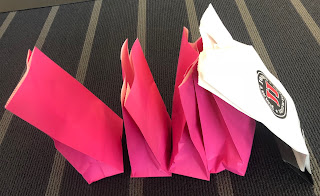 |
| My shot glasses in kids' party favor bags and Les' in a Jimmy John's bag |
The exchange was well organized and lots of fun, though it appeared to be exhausting for the people running it. After people got their bags, they went to sit at the large round tables and opened up their prizes, talking with other buddies about the pieces and comparing what they got. I got a colorful and elegant shot glass, a fun textured "shot glass" that appeared to be a mug, and a shot glass with a carved foot stamped with NCECA 2018 on the side.
 |
| The shot glasses I traded for at the Clay Buddies event. The artists' names are somewhere under this pile of paper from NCECA on my desk. |
To trade, I brought four shot glasses I made and one made by my community studio helper, Les. I got back four shot glasses and a mug with really interesting glazed texture. Les wasn't able to attend the conference, but I was texting him NCECA pictures and updates during the day and he kept me informed when he saw our shot glasses in other Clay Buddies' pictures.
 |
| The "shot glass" mug from the Clay Buddies event. The artist's name is somewhere under this pile of paper from NCECA on my desk. |
That evening, my friend Nina was running late after catching the wrong bus, so I had a delicious solo sushi dinner, next to the most obnoxious
Pumpkin Spice Latte woman. Since Nina wasn't back yet, I decided to go to the opening keynote for the conference, which looked promising because it was about education and the arts. Unfortunately one first has to sit through all the NCECA folks congratulating each other on doing the conference. I was fairly disappointed in the keynote itself. The speaker was an educator/education teacher and improv actor who seemed to think she had an innovative idea about getting kids creatively involved in their education. Sadly no one got creatively involved in her powerpoint, but the larger issue was the lack of innovation in what she had to say.
 |
| The texture on this mug is great fun! |
I was annoyed because she was talking about this program she runs where professional or amateur adult actors come into elementary schools, help kids write a play and then the actors perform it. The program sounds fine, but it isn't "new." Our elementary school brought in a musician who helped all the classes write songs, then he performed them for us. It was fun. It's a neat program, but it isn't new. She spoke as if her ideas were amazing and revolutionary! I was also annoyed because this wasn't much different from what a group of unpaid educators were discussing and advocating in my Topical Networking session, yet this lady was the (paid) keynote for the conference.
 |
| The crowd on the second day (Thursday) of the conference was shocking compared to the day before. This picture is from the hallway looking down on the expo hall. I shared this hallway with less than half a dozen people at a time the day before. |
I ended up leaving the keynote early to go find Nina. I was much happier leaving the talk than staying put, but part of my problem was nerves before my presentation the next day. (Though I suspect I would have been gently annoyed at the keynote without the nerves.) On Thursday morning I was scheduled to
speak about my own artwork for less than 10 minutes, which somehow made me much, much more nervous than leading a discussion about teaching for an hour. Nina was exceedingly patient with me as I fretted about the talk and she helped me practice it after we got back to the hotel.
 |
| On of my images from my Thursday presentation on my own work. |
One more note, I didn't have much imagery from my Topical Networking session or the keynote, so I included images from two shows that were taking place in the same hallway as my session. One was
"Garden (Feast) of Paradise" featuring work by
Anat Shiftan, Sanam Emami, Dominique Ellis, Julia Galloway, Ibrahim Said , and Sarah Heitmeyer. The other was "Ceramic Sculpture Culture: Unifying the Narrative Figure" featuring a variety of artists, but I shared work by Kevin Rohde and Travis Winters. I also shared work by C. J. Niehaus and Brett Freund. All my links should work (in the captions and this paragraph). Go check out these great artists and their other work.
















